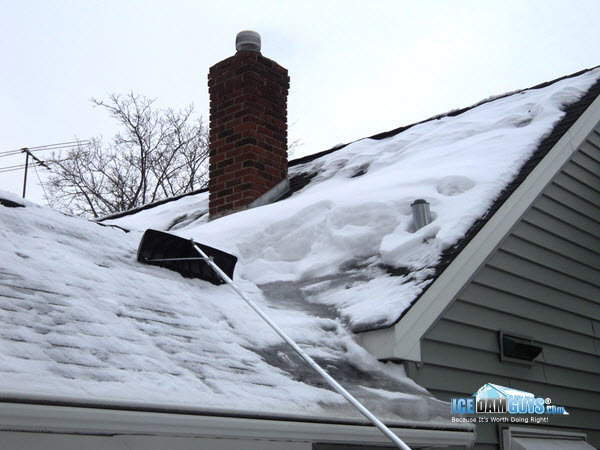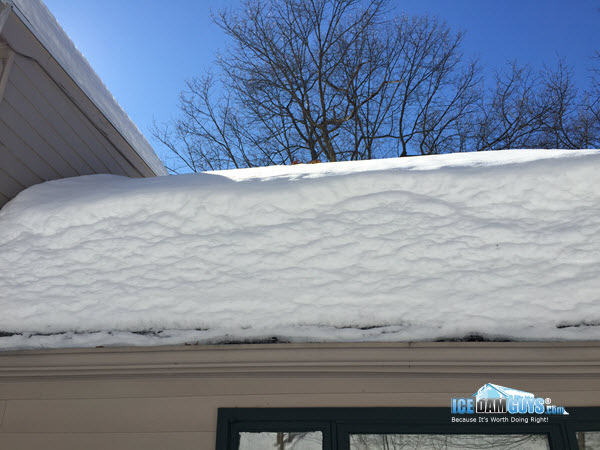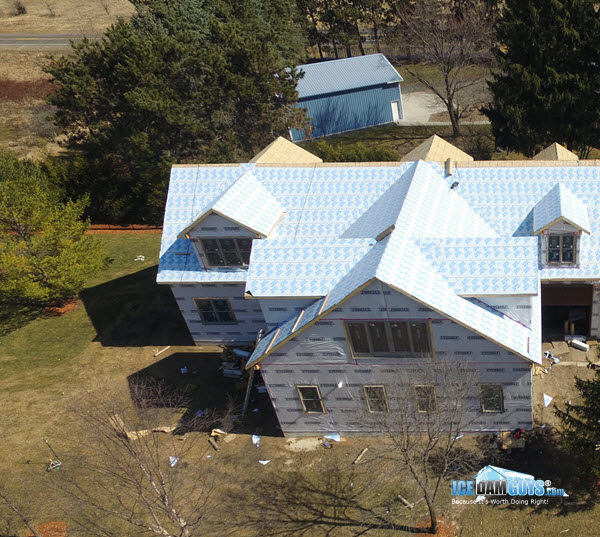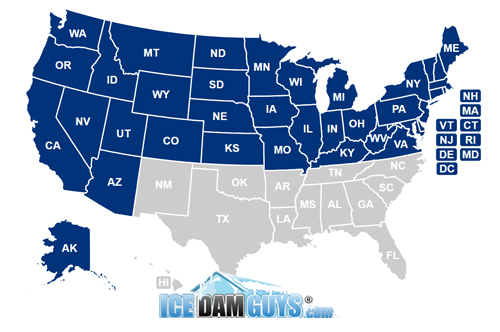Ice Dam Prevention

As ice dam removal professionals, we have two main strategies to prevent ice dams.
The first strategy is to provide you with as much free information as humanly possible to help you help yourself. If you read this page from start to finish then ice dams will be a rare occurrence in your home.
Our second strategy is to offer snow removal services in addition to ice dam removal services. (Contact us now if you want our personal help in preventing ice dams. Otherwise, simply read on to learn how you can prevent ice dams without us.)
Understanding Ice Dams
Understanding ice dams is the first step in preventing them.
If you’re not sure what an ice dam is, take a moment to read “What is an Ice Dam” over in our Learning Center.
Ice dams are formed when snow melts, runs down your roof, and re-freezes near the overhangs, building a wall which traps more melted snow behind it.
Ice dam prevention efforts tend to fall into one of two categories:
- Ensuring on your roof snow does not melt.
- Ensuring there isn’t any snow on your roof to melt in the first place.
There are only four causes of ice dams:
- A hot attic. Your hot attic turns your rooftop into a stovetop, virtually guaranteeing snow-melt.
- Fluctuating temperatures. Typically, temperatures rise and melt snow during the day, and then plunge at night, refreezing the snow.
- Radiant heat from the sun. That can melt snow even when temperatures hold steady.
- Certain “perfect ice dam temperatures.” Temperatures between 30 and 32 degrees present a risk, because it only takes a little bit of heat either from the attic or from the sun to melt snow.
Of these four causes, “hot attics” are the most common.
Why doesn’t all the melted snow just run harmlessly off your roof?
Two reasons:
The anatomy of your roof is one reason. Even if you’ve got a hot attic, some places on your roof are colder. Usually, you’ll find these places around the overhang of the roof: the spots near the edge of your roof that hang over your house. The attic doesn’t heat those parts from underneath, so they remain cold. They’re often rimmed with metal gutters, which can get even colder. Gutters don’t cause ice dams, but they do extend your overhang, and they hold freezing temperatures quite well. There may be other places on your roof that do not touch the attic directly. Those areas are vulnerable to ice dams, too. As soon as the melted snow hits those cold areas it will freeze again.
The other reason melted snow stays on your roof long enough to cause problems is the leisurely nature of the drip. The melted snow (the water) drips along the top of the snow pack slowly. It’s not like watching water run along a smooth surface. Rather, it takes some time to get to the edge. Plenty of time to freeze, even before making it to the cold overhangs. That’s one reason ice dams can form anywhere on your roof. It’s also why the water never makes it to the ground.
Why We Can’t Promise to Help You Prevent 100% of All Ice Dams Forever
Ice dam prevention can only increase your chances of avoiding ice dams. Even if you’ve truly done everything you can do, weather conditions still can cause an ice dam. It might take a winter snowstorm that puts a foot of snow on your warm roof and refreezes it before you can rake it away, coupled with a day of radiant heat that creates a problem before you can respond.
It’s not common, but it can happen.
Want to try to spot those weather conditions? Check out: How to Forecast Ice Dams.
Ice Dam Prevention Technique #1: Get the Snow Off Your Roof

If there is no snow on your roof then there is nothing to melt. This method of ice dam prevention denies ice dams the food they need to grow. Snow removal is the best way to prevent ice dams, and in many cases the most cost-effective and easiest way.
But to make it work you must stick with it.
You’ve got two choices: You can rake the snow off the roof yourself, or you can have it done professionally. (Yes, we offer roof snow removal.) We highly recommend roof snow removal if you do not have the time or inclination to remove the snow yourself. We also recommend it if you are a snowbird who doesn’t want to return from a toasty climate only to discover that an ice dam has destroyed your house.
A note on DIY snow removal vs. professional snow removal:
DIY snow removal isn’t a bad thing at all if you’re doing it right. You’ll need a proper roof rake. Pick one made of plastic, or one that has small rollers or bumpers in the wheels to protect your shingles.
You’ll also want to observe proper roof-raking technique. The most important thing is to remove the snow in layers, a bit at a time, and to start at the bottom of your roof, working your way up.
It isn’t hard. But sometimes it can be tough to remove all the snow from your roof. If any snow remains, there is still a chance that an ice dam will form at the spot where you stopped raking. You shouldn’t do a partial job if you have a home that’s particularly prone to ice dams.
Ice dam removal is much more expensive than simple snow removal. On the other hand, calling a snow removal company every time there’s a flurry is another good way to spend more than you’d like. The most ice-dam-resistant homeowners usually rake the bulk of the snow themselves, and only call us after major snowstorms to take care of snow buildup that’s just impractical to handle.
Ice Dam Prevention Technique #2: Make Your Hot Roof Cooler
You have to think about why your roof is hot in the first place. The answer is that heat escapes from the living spaces to your attic, where it gets bottled up.
To keep the heat where it belongs, you need to do several things:
- Improve the insulation in your attic, to minimize the heat that enters the attic, and to absorb the rest as much as possible.
- Improve the ventilation in your attic, so the heat can escape.
- Look for places where heat is being sent directly to your attic, and either block or remove them.
We highly recommend that you get a home energy audit. Home energy professionals can tell you where you are losing the most heat. We also recommend having a roofer improve your insulation and ventilation. Also, check your bathroom and kitchen exhaust fans. Sometimes they vent directly into your attic, where they send a blast of heat to the roof.
Turning the heat down doesn’t hurt either. Easy (if sometimes uncomfortable) way to cool off your attic and roof.
What if you have cathedral ceilings? They’ll need a lot more TLC. You’ll probably need to re-insulate the ceiling and/or have a contractor create an air barrier. When you have a cathedral ceiling there is very little buffer between the heat you’re using to warm your toes and the snow-melting, ice-dam-causing hot roof.
The best time to do all of this is during the summer months. It’s too late by the time Old Man Winterarrives. Yes, it will cost you some money. And no, shortcuts like attic fans won’t get you anywhere. Choose your pain: pay once and dramatically reduce your chances of getting ice dams, or pay for ice dam removal services repeatedly, possibly every winter.
Ice Dam Prevention Technique #3: Deal With Your Trees
Trees hanging over your roof can create all sorts of shady spots where ice dams can easily form. Remember: the melted-snow runoff refreezes when it hits the cold spot on your roof. Any shaded areas of your roof may be 5 to 15 degrees cooler than the rest of your roof.
You want the entire roof to match as closely as possible the temperature of the air outside. Not too hot, because you don’t want melting, and not too cold, because you don’t want to create places for melting snow to get refrozen
Ice Dam Prevention Technique #4: Get the Right Kind of Roof
Replacing your roof mays pare you from dealing with ice dams in the future. You can pursue one of two tactics.
One option is to get a standard asphalt roof, but ask your roofer to install ice and water shielding under the whole roof (or most of it), and not just under the small part of the roof that he’ll probably cover by default.

Ice and water shielding will not prevent ice dams. But it will keep water out of your home. If you don’t have a leak, you don’t have much of an ice dam problem (as long as the ice dam isn’t causing any structural damage). You may still want to get the snow removed if it becomes too heavy. More than 2 feet of snow on your roof is a cause for concern.
The other option is to install a metal roof. Metal roofs prevent ice dams, because the ice has nothing to grip. They’re also less likely to leak. Unlike a shingled roof, a metal roof does not provide hundreds of opportunities for water to work its way under shingles. If you want the closest thing to an ice-dam proof roof that money can buy, a metal roof is the way to go.
A Short List of Ice Dam Prevention “Solutions” That Do Not Work
If you’ve been paying attention, you know many of the solutions I’ve presented here cost time or money or both. In some cases they’ll cost a lot of time, or a lot of money.
It’s at this point people begin desperately searching for a cheaper solution. The most common ones are heat cables, heated gutter guards, and salt pucks.
- Heat cables do not work because they don’t have enough “juice” to remove all the snow. Instead, they melt just a little snow – just enough to refreeze somewhere else on your roof.
- Gutter guards won’t help, because gutters do not cause ice dams. Even clogged gutters do not cause ice dams. Gutter guards actually make it harder for us to perform ice dam removal later. Heated gutter guards are the lovechild of two bad ideas: they melt just enough snow to make your ice dams worse, and the guards get in the way of our ice dam steamers.
- Salt pucks. These are little hockey-puck or brick shaped blocks of salt that people throw on their roof. They do not prevent ice dams. They melt little holes in the ice, but they don’t melt enough snow to get the job done. The salt damages and discolors your roof. If you have a leak later, salt and perhaps nasty additives will leak into your home, compounding the water damage. The same is true of the salt-filled-pantyhose technique.
TL;DR: Ice Dam Prevention in a Nutshell
What causes ice dams? Snow melting and refreezing. How can ice dams be prevented? By keeping the snow off your roof.
Don’t want to deal with a single one of our ice dam prevention suggestions? You can call us. We’re not just an ice dam removal company: We also offer roof snow removal to all of greater Minneapolis / St. Paul and beyond.
We can shovel the snow or (more likely) rake it from your roof; it just depends on your exact roof type and what’s the quickest, easiest, and safest way to remove the snow. For larger commercial jobs, we may even use a snow blower.






















